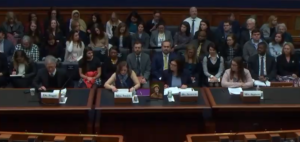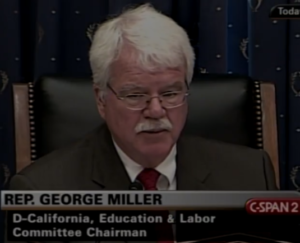#HandsOff Our Kids: Advocating Against Restraint and Seclusion
#HandsOff is a series on The Arc Blog. Each month, we feature a story from individuals and families across The Arc’s network about how some of today’s key policy issues impact their day to day lives.
By: Erik Smith
I went to Washington last month to support my wife in sharing our family’s story about restraint and seclusion. A few weeks before, the new executive of The Arc Rhode Island Family Advocacy Network put out a call to find families who would be willing to provide testimony at a Congressional hearing on this topic. Needless to say, my wife Renee and I jumped at the opportunity. We had mixed feelings about making our family’s experience so public, but felt strongly that we needed to advocate for all families to help them avoid the painful and unnecessary practices of restraint and seclusion that our son Dillon, who has autism, had experienced repeatedly in kindergarten and the first grade.

Renee started her testimony by describing what our daily lives used to be like. She recounted the regular instances of restraint and seclusion that Dillon experienced, the multiple calls to 911 made by the school, Dillon’s increasing dislike of school, his missed educational opportunities, and the overwhelming stress on our family. I felt proud of Renee as I watched her recount, sometimes through tears, how much harm this had caused our then 6-year-old son and our family as a whole, including our marriage and our jobs. Fortunately, Renee was able to end her testimony on a very positive note. After we moved Dillon to a different public school in the same district that uses positive behavior intervention and support, Dillon is thriving.
In preparing for the hearing, we had the chance to learn more about the history of federal legislation to limit restraint and seclusion. We learned about a law (the Children’s Health Act of 2000) that includes serious limits on these practices. The only problem is that it doesn’t include school settings.
As I listened to Renee, I was struck by the contrast between my professional and personal life regarding the limitations on restraint and seclusion. I am a nurse and I work in a long-term care facility. The Centers for Medicare & Medicaid Services (CMS) strongly regulate the use of restraints in LTC facilities, with these regulations to be enforced through state Health agency survey and certification. I have always been well aware of what I can and cannot do when our patients exhibit challenging behaviors. I have received training by my employer on patient’s rights, on what we are legally barred from doing, and on effective alternatives to restraint and seclusion. I see firsthand how this benefits our patients and staff alike. But as a parent, I see how the lack of such protections have hurt my son.
This point was made in 2009 by the former chairman of the House Education and Labor Committee, Rep. George Miller, the last time there had been a hearing on restraint and seclusion:

“Federal law restricts the use of seclusion-restraints to emergency circumstances for children in hospitals and community-based residential treatment facilities and other facilities supported by federal dollars. Yet these rules do not apply to public or private school. This means an untrained medical professional is forbidden from inappropriately restraining a patient and, if they do, there are laws specifically targeted to address such behavior. But untrained classroom staff are abusing student in schools without any accountability because of a lack of federal oversight. Our children are bearing physical and emotional burden of a system designed to fail them”
It is now almost a full decade later. Far too many children like my son continue to be restrained and secluded in school. It is past time to correct this problem.








